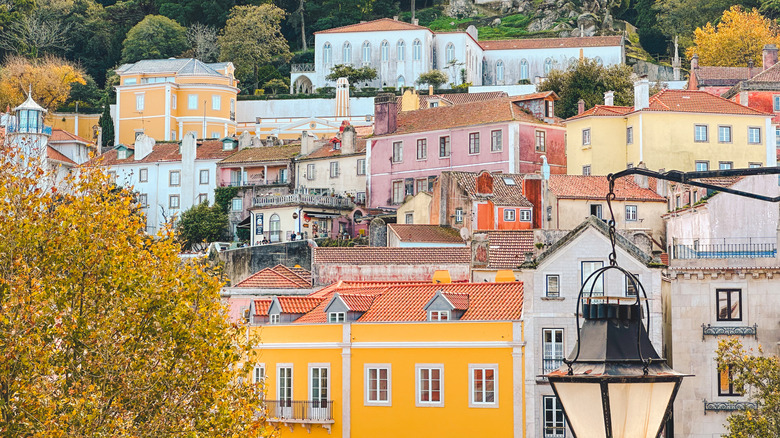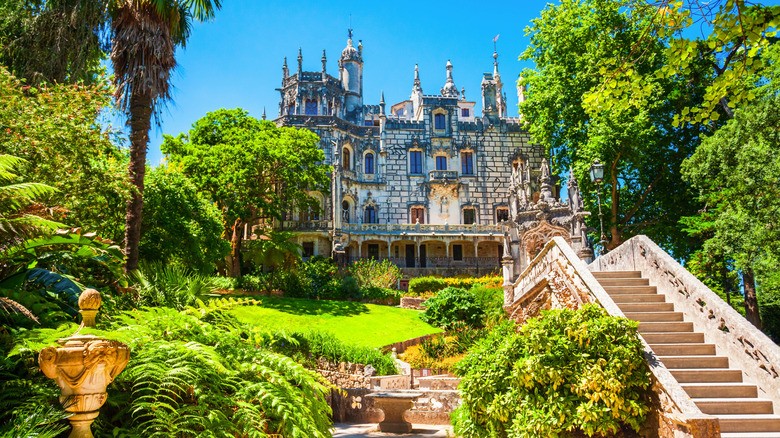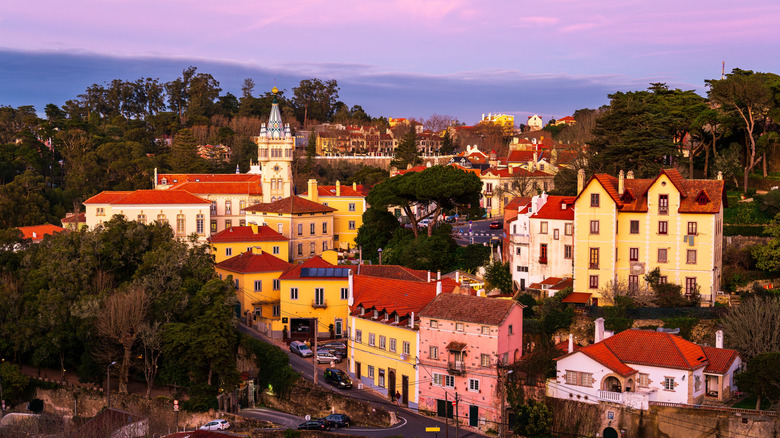Portugal's Mountains Boast A Timeless Fairytale Town With Otherworldly Palaces And Enchanting Gardens
A hamlet of narrow roads winding around a forested mountainside, Sintra is about as fairytale as destinations come. Located 15 miles northwest of capital city Lisbon, the quaint town was built up by Portuguese royalty and nobles escaping the summer heat of the capital city — which hits around 86 degrees Fahrenheit in July and August. Small wonder the rich folks headed to a higher altitude and cooler climate to build their ornate summer palaces and villas, with added security and privacy thanks to the surrounding trees.
The town is a UNESCO World Heritage Site and an incredible example of design in the era of 19th-century Romanticism. Today, Sintra is one of Portugal's most popular destinations — largely thanks to Pena National Palace and its incredibly unique designs — but there's a lot more to Sintra than that. Aside from the gorgeous palaces, gardens, and museums, it's a bustling town with a great cafe culture and summer festivals.
Sintra is easy to visit from Lisbon, too, with a direct train route that takes just 35 minutes. Once you're in town, getting around is simple using Scotturb tourist bus service routes 434 and 435. It's a well-priced, hop-on-hop-off service, with a ticket that lasts 24 hours and drops you outside the entrance to most of the palaces in town and in the hills. But despite the buses being as regular as every 10 minutes during the high-season summer months, you'll still likely have to wait some time to get back down into the town center, as peak season sees so many visitors. The other options are taxis or tuk-tuks, so if you're traveling in a small group sharing costs, these can be ideal alternatives.
Explore the enchanting gardens and famous palaces of Sintra
The density and diversity of the palatial architecture in Sintra is impressive, from Romantic to neo-Gothic to Moorish, all just minutes apart. The most famous is the previously mentioned and ever so iconic Pena National Palace. The timed-entry tickets for this site should be bought in advance, and you may receive a 15% discount if you do so at least three days before your visit. After you've been wowed by the decadent furnishings inside and looped the palace exterior for pics, be sure to take a stroll in its gardens which have miles of walking paths that are home to over 2,000 species of plants.
Dating back to around the 10th century, the National Palace of Sintra, with its white, conical spired roofs, is one of the first of the town's sites you'll run into, as it's located in the center before you drive (or hike, if you're ambitious) up into the mountains. The place to head for the fanciest garden features and follies you've ever seen is Quinta da Regaleira, an austere-looking, neo-Gothic villa with vast grounds. Its famous spiral staircase, the Initiation Well, has scary secret-society vibes, but you'll want to descend with the crowds anyway.
The Moorish Castle is the oldest in town, dating back to the 8th and 9th centuries when the south of Spain and Portugal were ruled by the Moors, a North African empire with its center in Morocco. The views from its brick walls and turrets are the best in Sintra, given that it's at one of the town's highest points — this castle was for military defense, after all, not entertaining nobles. No matter how many of the palaces you manage to visit, you can rest assured you've seen some of the best fairytale castles in Europe.
Other noteworthy stops in Sintra
While people will tell you that Sintra, like Lisbon, is one of the least walkable cities in Europe, if you've got time to slow travel, it's well worth spending a week or two in the hilly town so you can ditch the bus services and enjoy the hikes between palaces. If time is on your side, tie up your laces and indulge (challenge) yourself as you view these magical emblems of Portugal's rich past. The fairytale palaces do look like a page out of Disneyland, but this town is still very much lived in and is home to a local population of almost 400,000 people. Consequently, there's a strong cafe culture and plenty of dining options.
Casa Piriquita is a great place to stop for a coffee and graze on the excellent array of pastries. Be sure to try the shop's travesseiros, a puff pastry stuffed with almond-flavored cream. If it's closed, pop around the corner to Piriquita II, the sister branch that keeps more reliable hours. Another top cafe stop is Queijadas da Sapa, which serves the Sintra speciality queijadas — cheese tarts topped with cinnamon. When you're ready for a full meal, Incomum by Luis Santos is known for amazing risotto dishes and moderate queues. If you're craving something different, try the tasting menu at Midori, whose Japanese-Portuguese fusion has a Michelin star for a reason: immensely tasty seasonal flavors.
A brilliant time to see the creative side of town come alive is during the annual Festival of Sintra, held for 10 days every June. Art and music performances pop up around Sintra featuring musicians, dancers, poets, and actors from across Europe and the world. But any time of the year is magical in Sintra, really — visit and find out for yourself.


